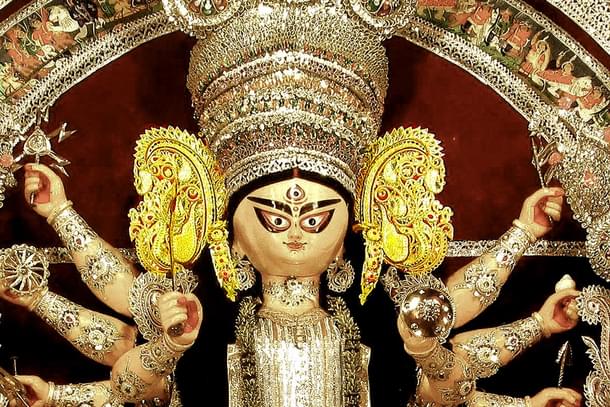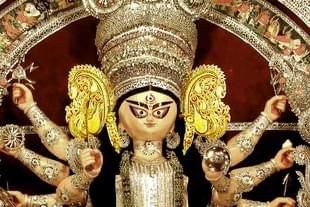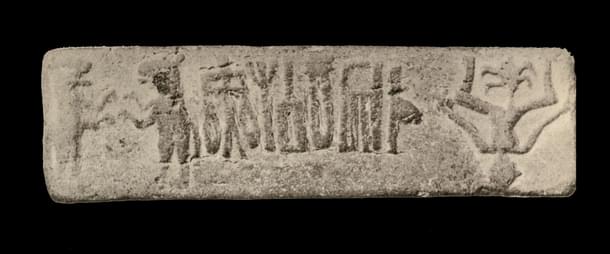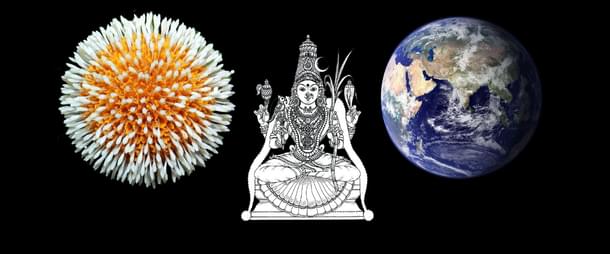Culture
Random Meditations Through Her 1,000 Names (XXI): The Flowers Adorning Her Ears
Aravindan Neelakandan
Jul 25, 2020, 06:21 PM | Updated Dec 16, 2024, 02:14 PM IST
Save & read from anywhere!
Bookmark stories for easy access on any device or the Swarajya app.


Read the previous part here.
The form of the goddess emerges from the fire pit — the inner fire pit. The Sahasranama now sings the beauty of her face, describing each of her divine organs.She is the resplendent one with capitate globose heads of kadamba flowers placed over her earlobes: Kadambamanjariklipta karnapuramanohara.
Kadamba (Neolamarckia cadamba) has a special significance for the goddess. In Sri Lalita Sahasranama, her 60th name describes her as residing in the kadamba forest. Then her 323rd name alludes to her love for the kadamba flowers. In the 330th name, she is said to love kadambari — the wine made of the flowers of kadamba tree.
In tantric rituals and in the devotion to the goddess, the kadamba tree occupies a very important place. In the hymn to Adya Kali in Mahanirvana Tantra, the goddess is hailed as one who wanders in the kadamba forest, one who is pleased with the flowers of the forest, one who has her abode in the kadamba forest, one who wears a garland of kadamba flowers and one who drinks the wine made of these flowers.The association of kadamba tree and the goddess tradition may go back well into the most ancient times in India.
In the Harappan or Sindhu-Saraswati civilisation seals, there is a very interesting one showing a vegetation emanating from the vulva of the goddess.

The plant thus emerging may well be the kadamba tree. That this Harappan symbol is an integral part of vedic and tantric streams of Hindu Dharma, is brought out by 'Manthanabhairavatantram' in its Kumarikakhandah: ‘samketam vrksamulam tu yonimadhye kadambakam’: “The tradition says the tree that is called Kadambaka has its roots at the centre of the Vulva of the Goddess.”
This text also calls her form as “(spherical like) that of a bud of the Kadamba tree” (kadambagolakakaram). This seemingly paradoxical aspect of the goddess — the kadamba tree is born out of her and she is the bud that sprouts off the tree — embodies in it a vision so integrated with Sanatana Dharma.
The early Upanishads had already compared the body of a man to a tree with its root the Brahman. Similarly, the mandala of the goddess is the tree within which she resides and over which she presides in the form of a Yaksini, an ancient India folk deity of vegetation and the earth. The whole tradition and its teachings are represented as the Tree of Consciousness which grows out of the Divine Current (divyogha) of the Divine Kaula tradition. ... (Kadamba tree) ... symbolizes the tradition and its growth from the Vulva of the goddess’s empowering Command. At times this tree is the mandala itself rather than a development of it. To be precise, it is the mandala that has been empowered by the Command of the goddess. The goddess thus fertilizes herself, as it were, to give birth to the cosmic tree. Krishna declares in the Bhagavad Gita that he is the asvattha with its roots in heaven and its branches here below. Similarly, the mandala empowered with mantra and the goddess’s energy, is the Kadamba tree which, blazing with energy, emits its rays of mantric power down into the phenomenal world. But she is not only the source of this tree, she is also born from it. She is the bud of the Kadamba flower. In this form she has engulfed into herself (kadambikrta) all the energies of the mandala and the cosmic order that it represents. Thus she contains every potential for growth and unfoldment. When the flower blossoms, she is its radiant energy which, led to the heart (the centre of one’s being where the Self resides), completes the cycle.Mark S G Dyczkowski, The Cult of the Goddess Kubjika: A Preliminary Comparative Textual and Anthropological Survey of a Secret Newar Goddess,Publications of the Nepal Research Centre; No. 23, 2001, pp.70-2
All the above would show clearly why the kadamba tree is important as a sacred ritual component and an inner imagery that has come with us in the goddess tradition from time immemorial.
Now let us relate back to the present name: Her ears are decorated with the manjari of kadamba flowers. Manjari means a bunch of flowers and it is also the natural arrangement of flowers in the way they blossom. It is called inflorescence. The kadamba flowers are arranged in groups in the form of a globe like structure with individual flowers having no pedicel.
There is more to it than definitely aesthetically pleasing poetic imagery. In Hindu tradition, this capitate inflorescence of kadamba has a specific implication. As of now we know that it was Aryabhata who employed this imagery first.
When establishing the shape of the earth, refuting those who considered, the famous astronomer-mathematician of the fifth century CE, states: Like as a ball formed by the blossoms of the kadamba is on every side beset with flowerets, so is earth-globe with all creatures terrestrial and aquatic.

This imagery is followed by other Hindu astronomers also. Bhaskaracharya the famous astronomer-mathematical poet of the twelfth century uses the same imagery and states:
... being made of earth, wind, water, void, fire, having no support other [than itself], by its own force stands in space firmly; on its back eternally everything is placed including the sons of Danu, of Manu, of Aditi and Diti everywhere. On all sides it is covered with multitudes of hills, groves, villages, temples, like the tight knot of the flower of kadamba with its multitudes of filaments.
Sanskritologist Dr Pierre-Sylvain Filliozat explains:
The kadamba flower, Lamarckiana cadamba, is here the most wonderfully appropriate standard of comparison. This image has been initially imagined by Aryabhaṭa and expressed in his forceful style in a arya stanza. Bhaskara has rewritten the stanza in a shorter anushtubh form with alliterations and with precise words, adding his elegance of formulation ... We have to emphasize the inspired character of this passage. We feel the enthusiasm of the poet astronomer, dragged by the beauty of the universe, carried away by his discovery of its divinely built structure. A saying of western astronomers in Latin is: coeli ennarantdeum “the skies describe God”. For Bhaskara the earth and other elements of the universe are bodies of Siva. All that is intense poetry of the most elevated level. And that could occur only in an astronomical account.Pierre-Sylvain Filliozat, The Poetical Face of Bhaskaracharya, in Bhaskara-prabha: Sources and Studies in the History of Mathematics and Physical Sciences (Ed K Ramasubramanian, Takao Hayashi & Clemency Montelle), Springer, 2019, pp.53-4
One can say that this floral imagery about the shape of the planet is then infused with what Einstein would have called the cosmic religious feeling. It is this imagery of the floral inflorescence along with the rich and sacred tradition kadamba tree has in the goddess tradition of Hindu Dharma that gets evoked by the name: Kadambamanjariklipta karnapuramanohara.
Aravindan is a contributing editor at Swarajya.





